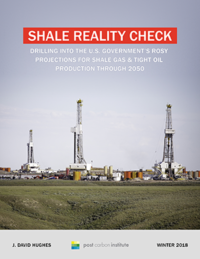
Shale Reality Check 2021
Fracking has boosted U.S. oil and gas production—but how long can it deliver? This assessment of U.S. government forecasts for tight oil and shale gas production finds them extremely optimistic and unlikely to be realized.

Fracking has boosted U.S. oil and gas production—but how long can it deliver? This assessment of U.S. government forecasts for tight oil and shale gas production finds them extremely optimistic and unlikely to be realized.

Shale gas and tight oil have provided a new lease on life for U.S. oil and gas production. But how sustainable is shale production in the long term given optimistic forecasts of robust production through 2050 and beyond? In this report, earth scientist J. David Hughes assesses the viability of the U.S. Energy Information Administration’s (EIA) shale forecasts in its Annual Energy Outlook 2019, which are widely used by policymakers, industry, and investors to make long-term plans. His detailed analysis finds that the EIA’s forecasts of tight oil and shale gas production through 2050 are extremely optimistic, and highly unlikely to be realized.

Este informe pretende cuantificar el impacto de los avances tecnológicos recientes en la producción de petróleo y gas compactos (“tight”), y proporcionar una evaluación realista del perfil de producción futuro en la gran mayoría de los campos de petróleo y gas de lutitas (shale) en Estados Unidos.

Shale gas and tight oil from low permeability reservoirs have provided a new lease on life for U.S. oil and gas production. The question is, how sustainable is shale production in the long term given optimistic forecasts of robust production through 2050 and beyond? Shale Reality Check: Drilling Into the U.S. Government’s Rosy Projections for Shale Gas & Tight Oil Production Through 2050 endeavors to answer that question by assessing the viability of the projections of the U.S. Energy Information Administration (EIA) in its Annual Energy Outlook 2017.

2016 Tight Oil Reality Check explores how the EIA’s projections and assumptions regarding tight oil have changed over the last two years, and assesses the AEO2016 against both Drilling Deeper and up-to-date production data from key tight oil plays.

2016 Shale Gas Reality Check explores how the EIA’s projections and assumptions regarding shale gas have changed over the last two years, and assesses the AEO2016 against both Drilling Deeper and up-to-date production data from key shale gas plays.

In Eagle Ford Reality Check: The Nation’s Top Tight Oil Play After a Year of Low Oil Prices, David Hughes—author of Drilling Deeper (which remains the most thorough independent analysis of U.S. shale gas and tight oil production ever conducted) and a number of other reports on North American shale gas and tight oil production—looks at how production in the Eagle Ford has changed after a year of low oil prices.

In Bakken Reality Check: The Nation’s Number Two Tight Oil Play After a Year of Low Oil Prices, David Hughes—author of Drilling Deeper (which likely remains the most thorough independent analysis of U.S. shale gas and tight oil production ever conducted) and a number of other reports on North American shale gas and tight oil production—looks at how production in the Bakken has changed after a year of low oil prices.

In this update to Drilling Deeper, David Hughes explores how the EIA’s 2015 tight oil projections and assumptions have changed over the last year, and assesses the AEO2015 against both Drilling Deeper and up-to-date production data from key tight oil plays

In this update to Drilling Deeper, David Hughes explores how the EIA’s 2015 shale gas projections and assumptions have changed over the last year, and assesses the AEO2015 against both Drilling Deeper and up-to-date production data from key shale gas plays